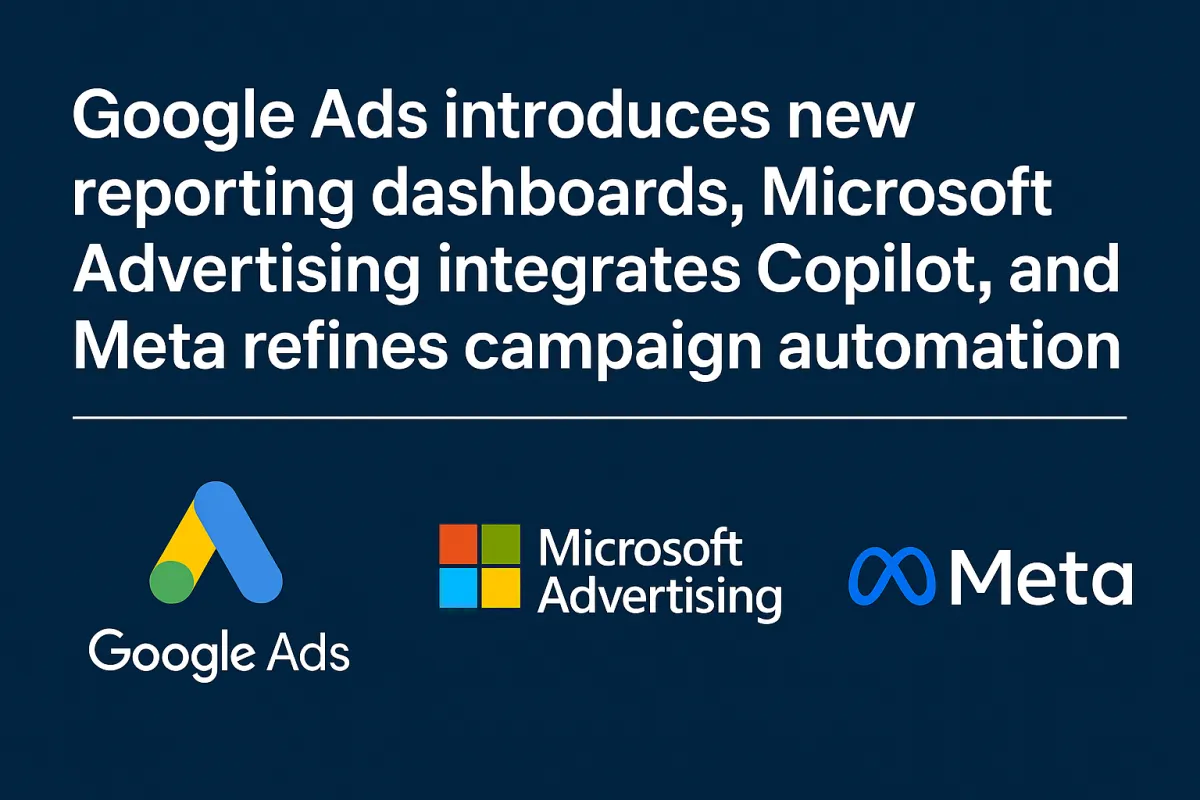
Google Ads Introduces New Reporting Dashboards, Microsoft Advertising Integrates Copilot, and Meta Refines Campaign Automation
The world of digital advertising is evolving rapidly, with major platforms rolling out innovations aimed at improving efficiency, transparency, and creative performance. Google Ads, Microsoft Advertising, and Meta are once again leading the charge with new tools that empower marketers to make smarter, data-driven decisions.
In this article, we explore Google’s enhanced reporting dashboards, Microsoft’s Copilot integration, and Meta’s refined automation systems — three developments that signal a major shift toward AI-powered advertising optimization.
Google Ads Introduces New Reporting Dashboards
Smarter, Centralized Data Views
Google Ads has launched new reporting dashboards designed to make campaign analysis more intuitive and actionable. The redesigned interface allows marketers to build custom, real-time dashboards within the Ads platform — eliminating the need for constant data exports to third-party tools like Looker Studio or Excel.
These dashboards enable advertisers to visualize campaign metrics, filter performance data by audience or device, and track conversions through easily configurable widgets. The goal is to simplify data interpretation while helping teams quickly identify what’s driving performance and what needs improvement.
AI-Powered Insights for Better Decision-Making
Google’s reporting dashboards are also enhanced with AI-generated insights, which automatically detect anomalies and performance trends. For example, the system can now alert advertisers when click-through rates drop unexpectedly, or when a specific keyword starts generating higher conversions.
This proactive approach helps advertisers act faster, optimizing their bids, ad creatives, and targeting strategies before performance issues escalate.
Cross-Platform and Campaign Comparisons
Another notable improvement is the ability to compare performance across multiple campaign types — including Search, Performance Max, and Display. This unified view gives marketers a holistic understanding of how their advertising budget is performing across Google’s vast network.
Ultimately, Google’s new reporting dashboards aim to reduce manual reporting time while providing advertisers with the clarity needed to make more confident, data-backed decisions.
Microsoft Advertising Integrates Copilot
AI Comes to Campaign Management
Microsoft Advertising continues to blur the lines between productivity and marketing with the integration of Copilot, its AI-powered assistant. Building on the success of Copilot in Microsoft 365, this integration brings generative AI directly into the advertising interface, helping marketers streamline campaign creation, optimization, and reporting.
Copilot can assist with tasks like writing ad copy, generating keywords, setting up campaigns, and even analyzing performance summaries. This feature is designed to help advertisers — especially small businesses — save time while improving campaign quality.
Natural Language Commands for Simpler Workflows
One of the most innovative aspects of Microsoft Advertising’s Copilot is the use of natural language interaction. Advertisers can now type queries such as “Show me the best-performing keywords from last week” or “Create a new campaign targeting product searches in Sydney.”
The system then interprets the request and performs the task automatically, greatly reducing the need for manual input or navigating multiple tabs. This conversational workflow makes the platform more user-friendly and efficient, especially for non-technical marketers.
Enhanced Integration with Bing and LinkedIn Data
Microsoft’s ecosystem advantage lies in its access to Bing search intent data and LinkedIn professional insights. Copilot uses these datasets to recommend optimized targeting and bidding strategies based on audience behavior and job-based demographics.
For example, an advertiser promoting B2B software can receive suggestions for ad copy tailored to IT decision-makers or operations managers — backed by real-world engagement data.
This fusion of AI and deep audience intelligence is positioning Microsoft Advertising as a serious competitor to Google’s ad network, particularly in the B2B and professional sectors.
Meta Refines Campaign Automation
Advantage+ Campaigns Get Smarter
Meta is further improving its Advantage+ campaign suite, continuing its mission to make campaign management more automated and performance-driven. These refinements introduce better machine learning models that help advertisers reach their ideal audience with minimal manual setup.
Meta’s AI can now test hundreds of ad combinations automatically, adjusting placements, creative variations, and targeting to deliver optimal results. This update helps brands focus on strategy and storytelling rather than technical campaign management.
Improved Budget Allocation and Transparency
A major focus of this update is budget optimization transparency. Advertisers can now see detailed breakdowns of where their budgets are being spent and which creative assets are performing best. This improved visibility helps marketers trust the automation process and make informed decisions about scaling successful campaigns.
In addition, Meta has improved its audience overlap detection and creative fatigue tracking — allowing advertisers to refresh their campaigns before engagement begins to decline.
New Tools for Lead Generation and Performance Reporting
Beyond e-commerce and app campaigns, Meta’s automation improvements are expanding into lead generation and service-based advertising. Enhanced reporting now provides granular insights into form completions, conversion quality, and downstream actions taken by leads after the initial ad click.
This holistic measurement helps advertisers evaluate campaign success not just by volume but by lead value and conversion intent, offering a clearer picture of ROI.
The Common Thread: Smarter, AI-Driven Advertising
Across Google, Microsoft, and Meta, one trend stands out — the deep integration of artificial intelligence in every stage of advertising. From automating reporting and creative testing to providing real-time performance insights, AI is transforming how marketers plan, execute, and measure campaigns.
These updates reflect the industry’s move toward data-driven creativity, where human strategy meets machine efficiency. Instead of replacing marketers, AI tools are designed to enhance their capabilities — freeing them from repetitive tasks so they can focus on innovation and customer experience.
Conclusion
With Google Ads unveiling powerful new reporting dashboards, Microsoft Advertising empowering users through Copilot, and Meta refining campaign automation, the advertising landscape is becoming more intelligent, automated, and interconnected.
As these tools evolve, one thing is clear: the future of digital advertising lies in AI-assisted precision, smarter insights, and seamless automation. Marketers who adapt to these innovations early will gain a distinct advantage in reaching audiences efficiently and effectively in an increasingly competitive marketplace.